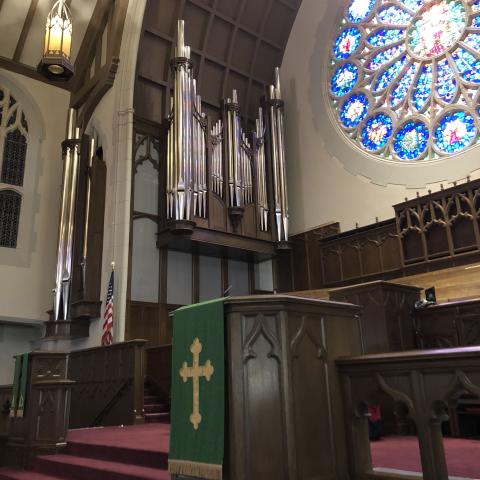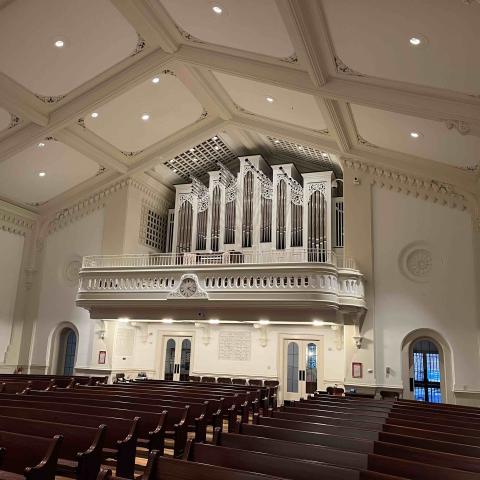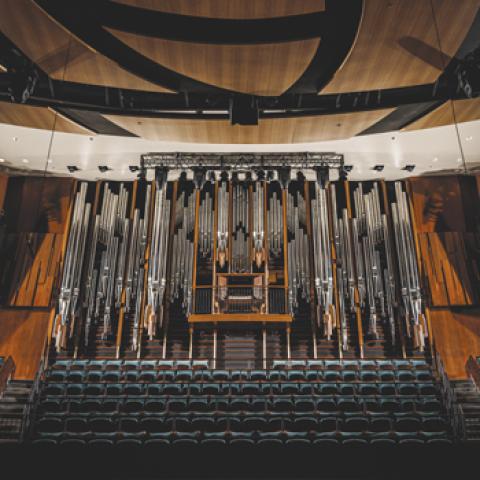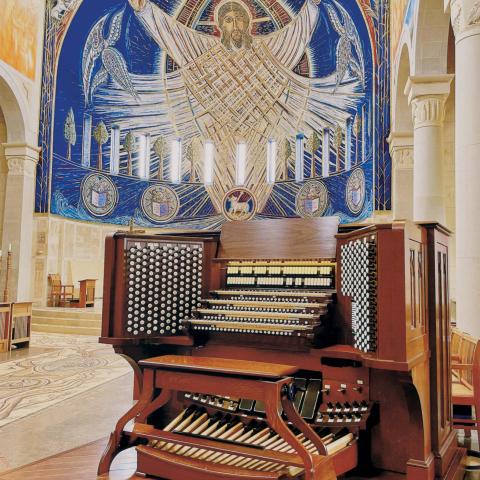Létourneau Pipe Organs, Saint-Hyacinthe, Québec, Canada; Brigham Young University, Provo, Utah

From the builder
New pipe organs are certainly cause for celebration, and a new pipe organ in a concert hall setting is especially worthy. Its visual presence reminds concert goers of the organ’s existence outside the church walls and acknowledges the instrument’s pride of place when it comes to acoustic music. The concert hall also presents unique opportunities for organists to add magic to almost any kind of musical presentation. With their new 81-rank Létourneau instrument, Brigham Young University is poised to reap the benefits that only a pipe organ can provide.
Discussions began in 2019 between BYU and Létourneau Pipe Organs about a new pipe organ for their forthcoming concert hall. The design was largely complete at that time, and the hall today is the core of BYU’s new music building. Compared with the classic shoebox-shaped concert hall, this venue’s vineyard-style architecture places the stage closer to the center of the hall such that no seat is more than fifteen rows from the stage. Behind and above the stage is the organ chamber, within which now resides Létourneau’s Opus 100. Its 45-foot-wide wooden façade was made from rift-sawn oak and walnut with vertical maple accents. Nestled into the casework are 93 speaking tin pipes taken from the bass octaves of the Great 16′ Double Open Diapason, the Great 8′ First Open Diapason, the Pedal 16′ First Open Diapason, and the Pedal 8′ Principal stops.
The university’s organists, Don Cook and Neil Harmon, expressed a desire for an instrument in English Town Hall style. To explain, it became customary from the mid-nineteenth century into the early-twentieth century for cities and towns in the United Kingdom to install significant pipe organs in their civic auditoriums, as well as to engage civic organists to perform on them. These instruments—along with the technological advancements they ushered in—facilitated the development of complex orchestral transcriptions by organists W. T. Best, G. D. Cunningham, and Edwin H. Lemare, among others.
Many of these instruments still exist in places like Birmingham, Leeds, Liverpool, Rochdale, Reading, Sheffield, and Ulster, not to mention London’s Royal Albert Hall. While each reflects its builder’s distinct tonal approach, they are broadly similar in style and can comfortably present the organ’s core repertoire on their own terms. They are just as adept at presenting colorful orchestral transcriptions or at standing in for an orchestra to accompany massed choirs. With due care when registering, these instruments are at ease with a Bach fugue, a Mendelssohn sonata, a Franck chorale, a Vierne symphony, a transcription of a Wagner overture, or fulfilling the organ part in Holst’s The Planets.
Our tonal plan for Opus 100 follows an established recipe: The organ features two distinct open diapasons on the Great, as well as open diapasons in the Swell and Choir divisions. The Great principal chorus is based on a 16′ Double Open Diapason with multiple mixtures to suit the desired effect; the Great is completed by a battery of trumpets on eight inches of wind. The Swell duplicates the Great in many ways but on a smaller scale, while the instrument’s more delicate effects are found in the Choir. The Solo division offers a powerful wooden flute stop, a briny pair of narrow-scale violes d’orchestre, and two orchestrally inspired reed stops. Brawny might be a good adjective for the Pedal division, with its two 32′ flue stops, a 16′-8′ Open Wood rank, and a compelling reed chorus from 32′ through 4′.
With the certainty that the organ would be heard alongside one of BYU’s many symphony orchestras, wind ensembles, or choral ensembles, additional fortifications are present in the form of two high-pressure tuba ranks. The first, the 16′-8′-4′ Tuba unit stop in Solo division, is voiced at just under fifteen inches of pressure and, with its smooth golden tone, can serve as the ultimate chorus reed for the manuals and pedal to bulk up the instrument’s sonic presence. The other, the 8′ Tuba mirabilis in the Choir, speaks on nineteen inches of wind and contrasts with more “point” in its timbre.
One of the parameters established from the outset was that the instrument would feature a console attached to the façade with mechanical key actions, as well as another console at stage level playing the instrument through entirely electric actions. Because of the substantial wind pressures required to fill the auditorium and concerns about the weight of the key actions, the attached console has been provided with Kowalyshyn Servo Pneumatic Levers to ensure the key actions remain responsive and proportional. Ensuring flexibility, both consoles offer a full complement of sub octave, unison, and octave couplers and a comprehensive system of pistons for up to 99 users with 64 memory levels each.
The designation of this instrument as Létourneau’s Opus 100 merits explanation as it continues a company practice wherein significant opus numbers are reserved for grand instruments that represent something of a tour de force. The first such instrument was the company’s Opus 50 completed at the Francis Winspear Centre of Music in Edmonton, Alberta, Canada, in 2002. There are similarities between Opus 50 and Opus 100: Both are large instruments that amply fill their respective concert hall with sound. In both cases, the pipe organ can be played from two consoles, with one attached to the instrument’s casework and the other moveable at stage level.
A pipe organ was always an integral part of BYU’s vision for its new concert hall, and we trust that this new and significant instrument will fulfill the university’s aspirations. It is humbling to think of the music that will come forth from Opus 100 from countless students, from BYU’s faculty, and from guest artists. Outside of solo presentations, there are also the many choirs that will be accompanied, or the orchestras and other ensembles that will be enriched, by the pipe organ’s unmistakable presence.
The entire Létourneau team is honored to have been selected to build this instrument and for our work to be associated with Brigham Young University into the future. It has been our pleasure to have worked with many fine people from BYU over the last five years, including Dean Ed Adams, Ray Bernier, Don Cook, Travis Dance, Jeremy Grimshaw, and Neil Harmon. We are grateful for their trust, for their patience, and for their unwavering support in our pursuit of artistic excellence.
—Andrew Forrest
From the musicians
Over many decades, the Brigham Young University organ program has enjoyed excellent practice facilities for organ majors and an organ lab for non-major organ study. However, access to a good concert organ has been difficult.
Moving to a new music building in 2023 created an opportunity to equip a 1,000-seat concert hall with a new pipe organ. The directors of our ensembles wanted an excellent instrument, and of course the organ faculty was poised to help bring a first-class organ to BYU.
A university organ committee was involved in the early stages of the new building’s design. We proposed an organ with two consoles—a tracker console in the façade and a movable console on the stage. An organ leaning in an English Romantic direction was proposed, to complement the French Romantic, Germanic, and American Classic organs in Salt Lake City.
Visits to several organs crafted by Létourneau in 2011 and 2019 led to a contract for a new four-manual, 81-rank instrument based on an English town hall scheme. The façade, designed by Létourneau with input from a BYU design committee, was to reflect the jagged-mountaintop theme echoed throughout the building. The terraced stage console allows easy view of the ensemble directors. The vineyard-style hall produces about two seconds of reverberation.
Organ alumni attended a conference underwritten by Marjorie Volkel following the organ dedicatory recital by Durham Cathedral organist Daniel Cook on October 25, 2024. One can imagine the joy they feel over their alma mater finally acquiring a concert organ that measures up to our active educational programs.
Current students are ecstatic over the new arrival and can access it regularly for practice, lessons, and performances. Although the new organ is located in a multi-use hall, administrators provide as much access as possible.
The inaugural season of performances includes solo recitals by faculty, alumni, and Salt Lake Tabernacle organists. Several choral and orchestral performances are scheduled, including the premiere of a new major work for women’s chorus and organ by Daniel Gawthrop. A community hymn sing is also scheduled.
The BYU community is set to enjoy the warmth, beauty, and power of this world-class organ for generations. We appreciate the university, the College of Fine Arts and Communications, the School of Music, and Létourneau Organs with Andrew Forrest for working together so nicely in the creation of this beautiful concert organ.
—Neil Harmon and Don Cook
Brigham Young University organ faculty
Builder’s website: www.letourneauorgans.com/
University website: http://cfac.byu.edu/organ
Inaugural season of events: organ.byu.edu/concert-hall-series/
Cover photo: Nate Edwards / BYU Photo
GREAT – Manual II – 130mm pressure
16′ Double Open Diapason, 61 pipes, 70% tin
8′ First Open Diapason, 61 pipes, 70% tin
8′ Second Open Diapason, 61 pipes, 56% tin
8′ Harmonic Flute, 61 pipes, wood and 56% tin, harmonic @ g32
8′ Viola di gamba, 61 pipes, zinc and 56% tin
8′ Stopped Diapason, 61 pipes, wood and 40% tin
4′ Principal, 61 pipes, 56% tin
4′ Open Flute, 68 pipes, 40% tin
2 2⁄3′ Twelfth, 61 pipes, 56% tin
2′ Fifteenth, 61 pipes, 56% tin
1 3⁄5′ Seventeenth, 61 pipes, 56% tin
2 2⁄3′ Grand Mixture II–III, 159 pipes, 12-15, 56% tin
1 1⁄3′ Mixture IV, 244 pipes, 19-22-26-29, 56% tin
1⁄2′ Sharp Mixture 183 pipes, 29-33-36, 56% tin
16′ Contra Posaune 61 pipes 56% tin, harmonic @ f#43, 205mm pressure
8′ Trumpet 68 pipes 56% tin, harmonic @ f#31, 205mm pressure
4′ Clarion 68 pipes 56% tin, harmonic @ f#19, 205mm pressure
Great 16, Great Unison Off, Great 4
8′ Tuba mirabilis (Choir)
Cymbelstern
Nachtigall
SWELL (enclosed) – Manual III – 140mm pressure
16′ Contra Gamba, 61 pipes, zinc and 56% tin
8′ Open Diapason, 61 pipes, 56% tin
8′ Concert Flute, 61 pipes, wood and 56% tin
8′ Gamba, 61 pipes, zinc and 56% tin
8′ Voix Celeste, 54 pipes from g8, zinc and 56% tin
8′ Bourdon, 61 pipes, wood and 40% tin
4′ Principal, 61 pipes, 56% tin
4′ Flauto Traverso, 61 pipes, 40% tin
2′ Fifteenth, 61 pipes, 56% tin
2′ Piccolo Harmonique, 61 pipes, 40% tin
11⁄3′ Mixture III–IV, 232 pipes, 19-22-26, 56% tin
16′ Double Trumpet, 61 pipes, 56% tin, harmonic @ c49
8′ Trumpet, 66 pipes, 56% tin, harmonic @ c37
8′ Oboe, 61 pipes, 56% tin, capped resonators
8′ Vox Humana, 61 pipes, 56% tin, capped resonators
4′ Clairon, 78 pipes, 56% tin, harmonic @ c25
Tremulant
Swell 16, Swell Unison Off, Swell 4
CHOIR (enclosed) – Manual I – 115mm pressure
16′ Lieblich Gedact, 61 pipes, wood and 40% tin
8′ Geigen Diapason, 61 pipes, 56% tin
8′ Rohr Flute, 61 pipes, wood and 40% tin
8′ Dulciana, 61 pipes, zinc and 56% tin
8′ Vox Angelica, 54 pipes from g8, zinc and 56% tin
4′ Fugara, 61 pipes, 56% tin
4′ Koppel Flute, 61 pipes, 40% tin
2 2⁄3′ Nazard, 61 pipes, 40% tin
2′ Gemshorn, 61 pipes, 56% tin
1 3⁄5′ Tierce, 61 pipes, 40% tin
1 1⁄3′ Larigot, 61 pipes, 40% tin
1′ Mixture III, 183 pipes, 22-26-29, 56% tin
16′ Contra Fagotto, 61 pipes, 56% tin
8′ Trumpet, 66 pipes, 56% tin
8′ Cremona, 61 pipes, new, zinc and 56% tin
Tremulant
Choir 16, Choir Unison Off, Choir 4
8′ Tuba mirabilis, 61 pipes, 56% tin, harmonic @ f#19, 495mm pressure
Great Reeds on Choir
SOLO (enclosed) – Manual IV – 280mm pressure
8′ Flauto mirabilis, 61 pipes, wood
8′ Viole d’orchestre, 61 pipes, zinc and 70% tin
8′ Viole Celeste, 54 pipes from g8, zinc and 70% tin
8′ Clarinet, 61 pipes, 56% tin
8′ English Horn, 61 pipes, zinc and 56% tin
Tremulant
16′ Contra Tuba, 12 pipes ext of 8′ Tuba, 56% tin, 400mm pressure
8′ Tuba, 61 pipes, 56% tin, 400mm pressure
4′ Tuba Clarion, 24 pipes ext of 8′ Tuba, 56% tin, 400mm pressure
Choir 16, Choir Unison Off, Choir 4
8′ Tuba mirabilis (Choir)
Chimes 37 notes Walker digital voice
Harp 61 notes Walker digital voice
Glockenspiel 61 notes Walker digital voice
Great Reeds on Solo
PEDAL – 150mm pressure
32′ Double Open Diapason, 12 pipes ext of 16′ Open Diapason, wood, Haskell construction
32′ Contra Bourdon, 12 pipes ext of 16′ Bourdon, wood
16′ Open Wood, 32 pipes, wood
16′ First Open Diapason, 32 pipes, 70% tin
16′ Second Open Diapason (Great)
16′ Bourdon, 32 pipes, wood
16′ Gamba (Swell)
16′ Lieblich Gedact (Choir)
10 2⁄3′ Grand Quint, 32 pipes, 56% tin
8′ Open Wood, 12 pipes ext of 16′ Open Wood, wood
8′ Principal, 32 pipes, 70% tin
8′ Spitz Flute, 32 pipes, 56% tin
4′ Choral Bass, 32 pipes, 56% tin
2 2⁄3′ Mixture IV, 128 pipes, 19-22-26-29, 56% tin
32′ Contra Posaune, 12 pipes ext of Gt 16′ Contra Posaune, zinc and 56% tin, 225mm pressure
16′ Tuba (Solo)
16′ Trombone, 32 pipes, 56% tin, 205mm pressure
16′ Fagotto (Choir)
8′ Tuba (Solo)
8′ Trumpet, 32 pipes, 56% tin, 205mm pressure
4′ Tuba Clarion (Solo)
4′ Clarion, 32 pipes, 56% tin, 205mm pressure
8′ Tuba mirabilis (Choir)
Great Reeds on Choir
Pedal Divide
82 stops; 81 ranks; 4,608 pipes
Couplers
Great to Pedal 8, 4
Swell to Pedal 8, 4
Choir to Pedal 8, 4
Solo to Pedal 8, 4
Swell to Great 16, 8, 4
Choir to Great 16, 8, 4
Solo to Great 16, 8, 4
Swell to Choir 16, 8, 4
Solo to Choir 16, 8, 4
Solo to Swell
Great to Solo
Swell to Solo
Choir to Solo
Consoles
• One four-manual and pedal console in the en fenêtre position with mechanical key actions and Kowalyshyn Servo Pneumatic Lever machines.
• One four-manual and pedal moveable console at stage level with electric actions.
• Common combination action between consoles for up to 100 users and 64 levels of memory per user. 8 Great pistons, 8 Swell pistons, 8 Choir pistons, 6 Solo pistons, 8 Pedal pistons and 16 General pistons, as well as multiple Next and Previous pistons.
Mixture Compositions
Great Grand Mixture II–III
c1 to b12 12 15
c13 to b24 8 12
c25 to b36 1 5 8
c37 to f#43 -5 1 5
g44 to c61 -8 -5 1
Great Mixture IV
c1 to b12 19 22 26 29
c13 to f#19 15 19 22 26
g20 to f#31 12 15 19 22
g32 to f#43 8 12 15 19
g44 to c61 1 8 12 15
Great Sharp Mixture III
c1 to g#9 29 33 36
a10 to f18 26 29 33
f#19 to d27 22 26 29
e28 to b36 19 22 26
c37 to g#45 15 19 22
a46 to e53 12 15 19
f54 to c61 8 12 15
Swell Mixture III
c1 to b12 19 22 26
c13 to b24 15 19 22 26
c25 to e41 12 15 19 22
f42 to d51 8 12 15 19
d#52 to c61 1 8 12 15
Choir Mixture III
c1 to a10 22 26 29
a#11 to g20 19 22 26
g#21 to f30 15 19 22
f#31 to d#40 12 15 19
e41 to c61 8 12 15
Pedal Mixture IV
c1 to g32 19 22 26 29







